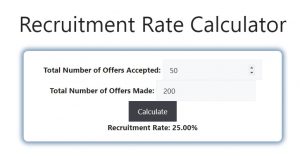About Recruitment Rate Calculator (Formula)
The Recruitment Rate Calculator is an invaluable tool for human resources (HR) professionals seeking to measure the effectiveness of their hiring processes. By calculating the recruitment rate, organizations can gain insights into how efficiently they attract and hire candidates. This metric is crucial for evaluating the success of recruitment strategies, identifying areas for improvement, and ensuring that the organization meets its staffing needs effectively. In this article, we will explain the formula for calculating the recruitment rate, provide step-by-step instructions on how to use the calculator, give an example, and address frequently asked questions.
Formula
The formula to calculate the recruitment rate (RR) is:
RR = (A / OM) * 100
Where:
- RR is the recruitment rate percentage.
- A is the number of hires made during a specific period.
- OM is the total number of job openings during that same period.
How to Use
Using the Recruitment Rate Calculator involves a few simple steps:
- Determine the Number of Hires (A): Count the total number of employees hired during the specified time frame (e.g., a month, quarter, or year).
- Identify the Total Openings (OM): Calculate the total number of job openings that were available during the same period.
- Input Values into the Formula: Substitute the number of hires and the total openings into the formula.
- Calculate the Recruitment Rate: Perform the calculation to determine the recruitment rate percentage.
Example
Let’s say your organization hired 50 new employees in the last quarter, and there were 200 job openings during that time. To calculate the recruitment rate, you would use the formula:
RR = (A / OM) * 100
RR = (50 / 200) * 100
RR = 0.25 * 100
RR = 25%
Therefore, the recruitment rate for the quarter is 25%, indicating that 25% of job openings were successfully filled.

FAQs
- What is a recruitment rate?
The recruitment rate is a metric that measures the effectiveness of the hiring process by calculating the percentage of job openings filled. - Why is the recruitment rate important?
It helps organizations assess their recruitment strategies and identify areas needing improvement to enhance hiring efficiency. - What time frame should I use for calculations?
The time frame can vary based on your needs, but common periods include monthly, quarterly, or annually. - How can I improve my recruitment rate?
You can improve your recruitment rate by enhancing job postings, utilizing multiple recruitment channels, and streamlining the interview process. - What constitutes a job opening?
A job opening refers to any position that is vacant and actively being recruited for within the organization. - Can the recruitment rate be less than 100%?
Yes, a recruitment rate below 100% indicates that not all job openings were filled during the specified period. - What is a good recruitment rate?
A good recruitment rate can vary by industry and organization, but generally, rates above 20-30% are considered effective. - How often should I calculate my recruitment rate?
It’s beneficial to calculate your recruitment rate regularly, such as quarterly or annually, to monitor changes over time. - Can the recruitment rate indicate issues in the hiring process?
Yes, a low recruitment rate may signal problems in your recruitment strategies or difficulties attracting qualified candidates. - How can I track the number of hires?
You can track hires through HR software, applicant tracking systems, or manually by maintaining a record of employment offers and acceptances. - Is the recruitment rate the same as the turnover rate?
No, the recruitment rate measures hiring effectiveness, while the turnover rate measures employee departures. - Can this calculator help with budget allocation for recruitment?
Yes, understanding your recruitment rate can assist in making informed decisions about recruitment budgets and resource allocation. - What role does employee retention play in recruitment rates?
High turnover can lead to increased recruitment needs, potentially lowering your recruitment rate if positions are frequently vacant. - How can recruitment rate data be utilized?
It can inform recruitment strategy adjustments, budget planning, and overall workforce management. - Are there industry benchmarks for recruitment rates?
Yes, various industries have different benchmarks, so it’s important to compare your rates within the context of your specific industry. - Can I use the recruitment rate to assess recruitment agencies?
Yes, monitoring the recruitment rate can help evaluate the effectiveness of external recruitment agencies. - How does recruitment technology impact recruitment rates?
Advanced recruitment technology can streamline processes, reduce hiring time, and ultimately improve recruitment rates. - What tools can I use to track recruitment metrics?
Many HR software solutions and applicant tracking systems provide built-in tools for tracking recruitment metrics. - How does candidate quality affect recruitment rates?
Focusing on attracting high-quality candidates can improve the chances of filling positions and positively impact the recruitment rate. - Is it necessary to consider candidate experience in recruitment rates?
Yes, candidate experience can affect your recruitment rate, as positive experiences can lead to higher acceptance rates for job offers.
Conclusion
The Recruitment Rate Calculator is a powerful tool for organizations aiming to enhance their hiring processes and strategies. By accurately calculating and analyzing the recruitment rate, HR professionals can gain valuable insights into their recruitment effectiveness, identify areas for improvement, and optimize their hiring strategies. Regularly assessing the recruitment rate enables organizations to stay competitive in attracting and retaining talent, ultimately contributing to their overall success.